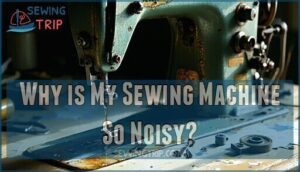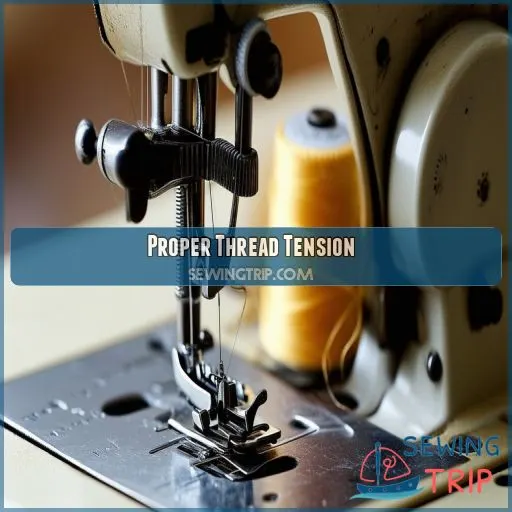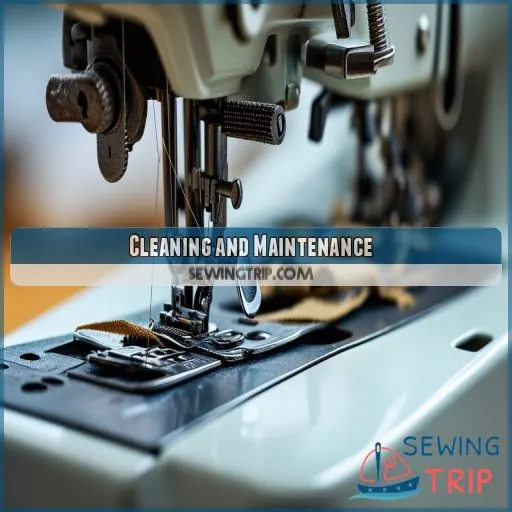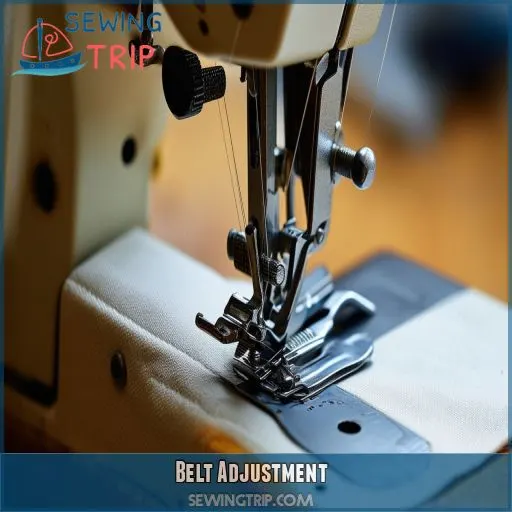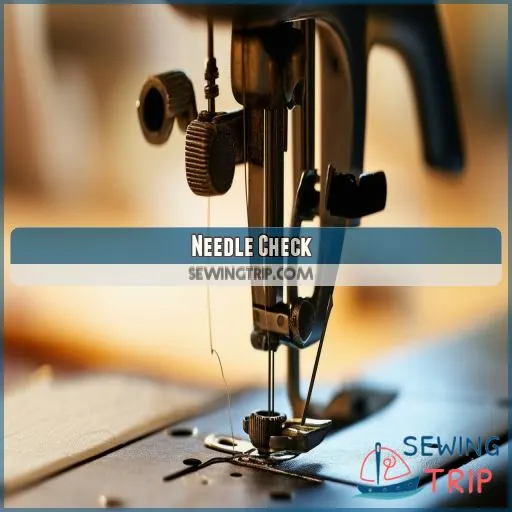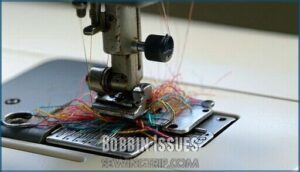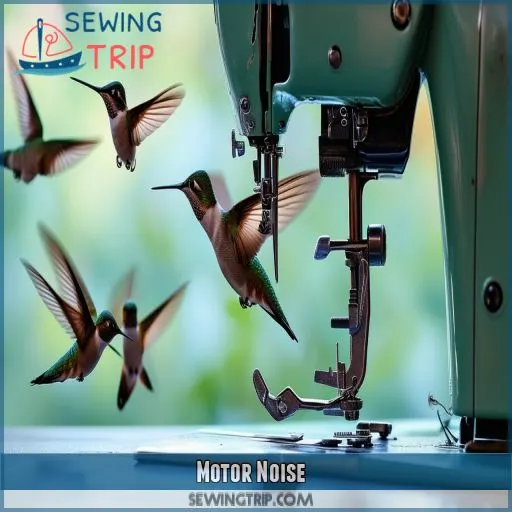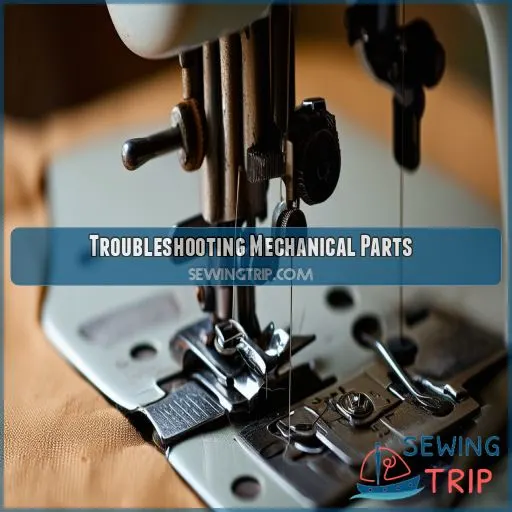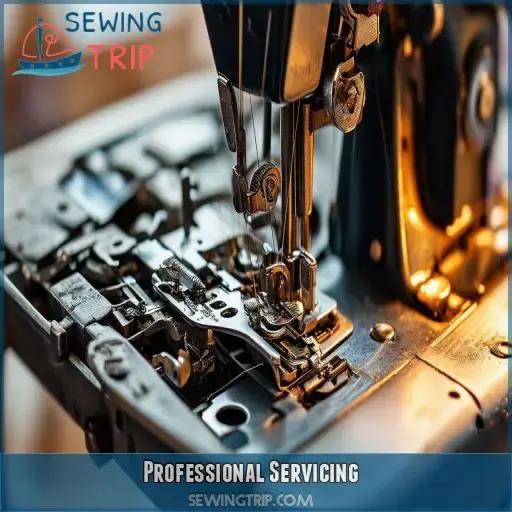This site is supported by our readers. We may earn a commission, at no cost to you, if you purchase through links.
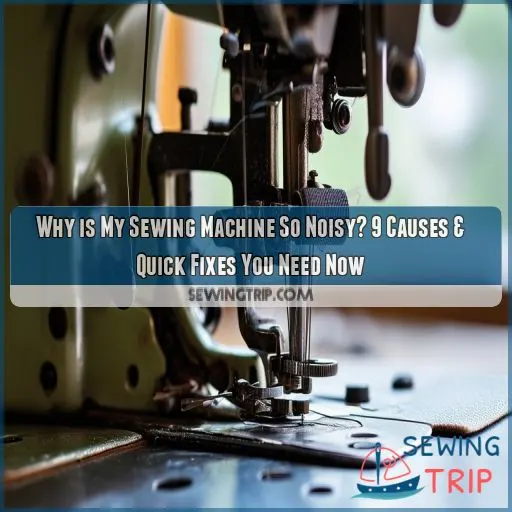 Is your sewing machine making enough noise to wake the dead? Keep calm! Noisy sewing machines are commonplace, and with just a few quick fixes, the problem may be corrected in no time.
Is your sewing machine making enough noise to wake the dead? Keep calm! Noisy sewing machines are commonplace, and with just a few quick fixes, the problem may be corrected in no time.
This guide walks you through 9 reasons your sewing machine is so noisy and what you can do to correct it. From machine lubrication to mechanical part troubleshooting, learn how you can identify and fix the source of the racket.
Just prepare yourself to restore peace in your sewing room and enjoy smooth and quiet stitching once more.
Table Of Contents
Key Takeaways
- Oil is the sewing machine’s best friend. Treat your machine to a little TLC by oiling it regularly. It’ll keep it running smoothly and sounding like a whisper.
- Thread tension is like Goldilocks’ porridge – not too tight, not too loose. Find the sweet spot where the upper and lower threads meet in the middle of your fabric. You’ll enjoy a quiet, smooth sewing experience.
- Cleanliness is next to quietness. Keep your machine free of dust bunnies and lint. They’re the noisemakers’ best friends!
- When in doubt, call in the pros. If your machine’s still making a racket after your DIY attempts, don’t hesitate to bring in a skilled technician. They’ll have your machine purring like a kitten in no time.
Why is My Sewing Machine So Noisy?
Is your sewing machine noisy? Then you face issues such as improper lubrication, problems in tension, or maintenance neglect.
It is always advisable to lubricate the machine four times a year by following the manufacturer’s guidelines without overdoing the process. Good tension for the thread is a factor important for quiet action; a little change can make a big difference.
Regular cleaning can further help keep the lint and threads out. Do not forget to check the needle and bobbin. Misalignment in this part causes most of the noise here. By ridding the damage or misalignment from this area, real peace and quiet can be continuously yours from here on in with professional servicing if necessary.
Want to solve that noise once and for all?
Machine Lubrication
Is your sewing machine sounding like a rusty locomotive? It might be begging for some TLC in the form of lubrication. Just like a car engine, your trusty stitching companion needs regular oiling to keep it purring smoothly.
Don’t go overboard – over-lubrication can be just as problematic as under-lubrication. Stick to the right lubricant type and frequency recommended in your machine’s manual. For most models, quarterly oiling should do the trick, but heavy users might need to up that to monthly.
A well-oiled machine is a happy machine, and a quiet one too!
Proper Thread Tension
Proper thread tension is key to enjoying a quiet, smooth sewing experience. If your machine is making a ruckus, it just might be asking for a tension adjustment. What you’re looking to achieve is that ‘sweet spot,’ where the upper thread meeting the lower thread is directly at the middle thickness of your fabric.
You should first check if the thread you’re using and your needle are of the right type for the thickness of your fabric. Mismatched uppers and lowers can cause an awful noise and also possibly damage some components.
Now check with a test piece. If the threads are looping loose or are tight, then adjust your upper tension dial just a little. Don’t forget, though, that with some stitch types, a small tweak may also be needed.
Proper tension is a game-changer in the troubleshooting and maintenance of sewing machines. Most of the time, it will resolve noise complaints without any additional measures.
Cleaning and Maintenance
But, in addition to this, regular cleaning and maintenance are also key to keep your stitching friend purring like a kitten. Dust bunnies and lint buildup can quickly change your old faithful stitching companion into a racketing nightmare. Stick to a cleaning schedule and be religious about it. After each project, take away lose threads and lint from the bobbin area, and the feed dogs, with the use of a brush. Also, don’t forget to clean those ‘hard-to-reach’ nooks and crannies, where debris loves to hide.
Oiling frequency is another valuable area of noise control. Follow your machine-specific manual recommendations, as excessive oil is nearly as detrimental to some machines as insufficient oil. In particular, keep moving parts lubricated, but avoid the accidental spreading of oil onto belts or electrical parts.
Belt Adjustment
Well, after cleaning your machine, let’s look at another villain of the noise cause—belts. Proper adjustment of a belt is quite important in a machine’s smooth operation. If your sewing machine is working heavily or you suffer thread breakages and looped stitches, then it’s probably time to check the belt.
First, figure out your belt type and material. The older machines typically use rubber belts; the new ones have several synthetic types. Belt tightness is crucial: too loose, and you’ll hear slipping; too tight, and it strains the motor. At about the center when you press on it, you should get about 1/2" of give in the belt.
Belt age and friction are also in play; an old and worn belt could be the cause of your machine being so noisy and poorly performing. If you notice cracks or fraying, it’s time for replacement. After all, not only would belt adjustment diminish the noise but also maintain the machine in good health to carry out quality stitching.
Gears and Timing
When your sewing machine starts to sound like it’s knocking, you have potential problems with gears and timing. These things work together to operate your sewing machine in such a way that it functions perfectly, but they can make a racket if not running properly.
Quite a racket can be caused by loose gears, while worn ones will engender a grinding noise. Don’t forget about gear lubrication – dry gears can squeal like nobody’s business.
The timing belt is another suspect; if it’s loose or worn, it makes your machine sound like it’s throwing a fit.
While some do-it-yourself zealots may go on to work on gear wear type problems, it’s often best to call in a technician for a proper timing adjustment.
Regular sewing machine cleaning can prevent many of these noisy problems.
Needle Check
More on troubleshooting a noisy sewing machine: your needle. A bent, dull, or wrong needle can cause all sorts of racket.
First, check the needle position. Is it in and tight? A needle that’s tightened in loosely will vibrate like nobody’s business.
Then, think about size and type. The wrong needle for your fabric can literally cause skipped stitches, puckered seams, and, of course, extra noise.
Examine the state of the needle, too. If your needle is dull or damaged, it won’t cleanly pass through the fabric. Instead, it will catch and rub on it, adding entirely too much noise and friction.
Lastly, be certain that your needle and thread are compatible with each other. Using greatly mismatched sizes will cause nothing but tension problems, and your machine won’t be able to feed it right, which is guaranteed to raise a ruckus.
A happy needle is a quiet and efficient needle, so give her some attention—that small metal workhorse.
Bobbin Issues
Bobbin issues: Now that you’ve checked your needle, let’s dive into the next biggest cause of noise on a sewing machine: issues with the bobbin. A bobbin is one of the most key elements when trying to achieve perfect stitches. When it’s out of line, however, it can seriously get into some rather noisy business, so here are four areas to check.
- Bobbin tension: Incorrect tension can lead to the bunching of the thread and noisy operation.
- Bobbin case: A damaged or loose case may rattle during sewing.
- Bobbin winder: Bad disengagement can result in unnecessary noise.
- Bobbin case: An improperly set bobbin case might vibrate and amplify sounds.
First, you take out the bobbin and check if it’s evenly wound and properly seated in the bobbin case. Make sure the bobbin-winding mechanism works freely and releases as soon as it’s full. Other noises mean you either need to change the bobbin or consult a professional over the issue.
Motor Noise
Apart from bobbin concerns, the other most common cause of noisy sewing machines is motor noise. The motor is the heart of your machine, and when it doesn’t beat right, you’ll hear about it. If you identify unnecessary humming, buzzing, or vibration of the motor, it’s time to take notice.
Noise may be a result of motor speed, so check if it’s running too fast. Another red flag is an overheating motor: it smells hot and is warm to the touch. Don’t take your chances with these red flags; they could lead to bigger problems.
Sometimes, this could mean the replacement of a motor, but don’t rush to do that just yet. Instead, make sure your motor is lubricated and free from debris.
Should the noise persist, the best option would be taking it to a professional technician to assess and repair.
Troubleshooting Mechanical Parts
If motor problems are ruled out, it means proceeding to the mechanical section of the sewing machine. The mechanical side of your sewing machine is often the cause of that annoying sound. Here’s what you should check:
• Timing belt: Belts that are loose or worn out could lead to a "knobby" noise expression. The best means to get rid of this is by replacement with a cleated belt.
- Gears: Overly tight gears in the front can cause the front end to stutter. Proper lubrication might help.
- Timing of needles and hooks: When this alignment is badly done, it can be the cause of many noises as well as difficulties in stitching.
- Feed the dogs: Look for loose debris or defective issues that might rattle.
Professional Servicing
Sometimes, despite your best efforts, your sewing machine’s noise issues persist. That’s when it’s time to call in the pros. Professional maintenance can address complex problems that DIY fixes can’t solve.
Before booking a service, check if your machine’s still under warranty coverage – you might snag a free repair. If not, weigh the repair cost against your machine’s age and value.
A skilled technician can diagnose and fix issues you might not even be aware of, potentially adding years to your machine’s life. When searching for a pro, consider technician availability in your area and their expertise with your specific model.
Frequently Asked Questions (FAQs)
How can I make my sewing machine quieter?
You can reduce your sewing machine’s noise by oiling it regularly, tightening loose screws, placing a rubber mat underneath, and ensuring it’s on a stable surface. Consider using high-quality thread and needles, as they’ll reduce friction and noise.
Why is my sewing machine making a loud noise?
Problems such as speaking loudly by your sewing machine can be due to some worn-out parts, loosened screws, and even improper lubrication. Ensure there are no leftover debris pieces around the bobbin area and that all parts are well-aligned. Regular maintenance can help prevent these problems.
What is the problem if sewing machine runs noisy?
Your sewing machine’s noise could stem from several issues: loose parts, worn bearings, lack of lubrication, or misaligned components. Regular maintenance, proper oiling, and checking for loose screws can often resolve these problems. If noise persists, consider professional servicing.
What causes a machine to run noisily?
Like a squeaky wheel, a noisy sewing machine cries for attention. You’re likely facing worn bearings, loose parts, or inadequate lubrication. These issues can cause friction, vibration, and rattling, disrupting your smooth sewing experience. Regular maintenance is key.
Can fabric type affect sewing machine noise levels?
Yes, fabric type can impact noise levels. Heavier fabrics may cause more vibration and resistance, increasing machine noise. Lightweight fabrics typically run quieter. Adjust tension and use appropriate needles to minimize noise with different materials.
Do different stitch patterns produce varying noise?
Yes, different stitch patterns can affect noise levels. Straight stitches are typically quieter, while zigzag or decorative stitches may produce more sound. The machine’s speed and complexity of the stitch pattern also influence noise output.
How does room acoustics impact perceived machine noise?
If you’re sewing in a room with hard floors and bare walls, sound bounces around, amplifying machine noise. Imagine sewing in a tiled kitchen versus a carpeted living room; the environment dramatically changes the noise level.
Can using a sewing machine mat reduce noise?
You can get rid of the vibration noise when sewing by placing a sewing machine mat underneath the machine, and it will absorb the vibration without transferring it to the working surface. That way, you have a quieter sewing space, and you’re allowed to concentrate much better during sewing.
Does machine age correlate with increased noise?
Yes, machine age often correlates with increased noise. Over time, components wear out, lubrication diminishes, and internal parts may become loose, leading to heightened noise levels. Regular maintenance can help mitigate these issues.
Conclusion
Ultimately, 80% of sewing machine issues can be resolved with simple DIY fixes. By understanding why your sewing machine is so noisy, you can quickly identify and address the root cause.
Whether it’s lubrication, tension, or a mechanical problem, the solutions outlined in this guide will have your machine purring quietly in no time.

